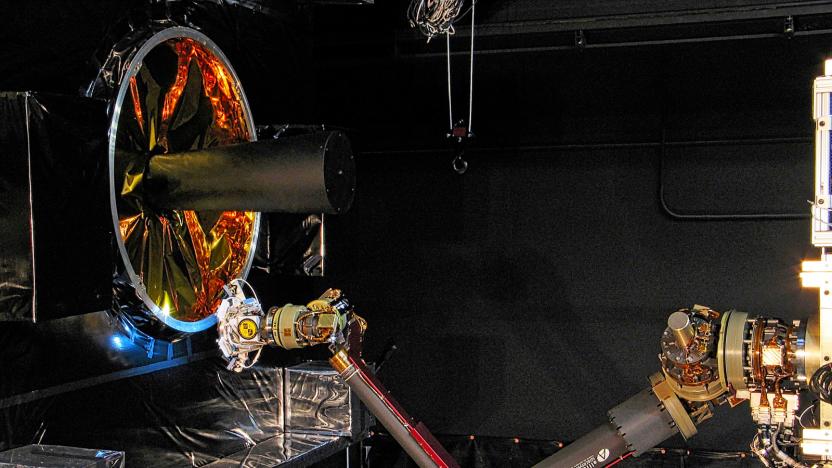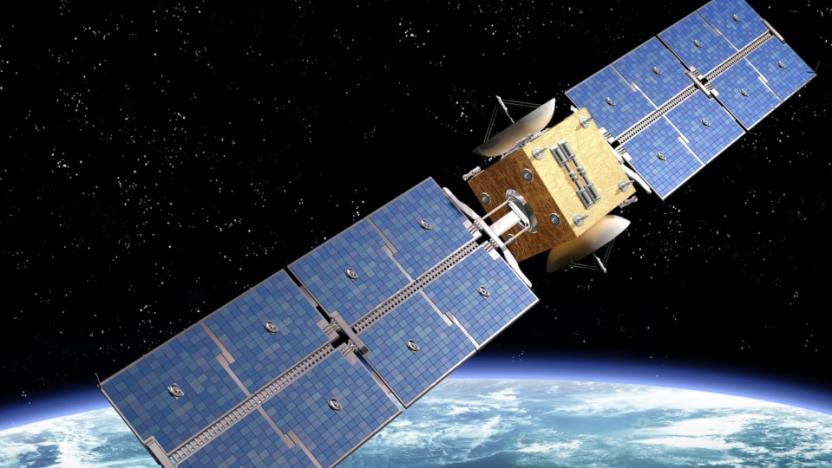satellites
Latest

Blue Origin shows how 'New Glenn' rocket will fly and land
Yesterday Blue Origin showed off the BE-4 engine for its "New Glenn" rocket, and today CEO Jeff Bezos revealed its launch customer and an animation showing how it'll fly. Its new ship is capable of putting a 50-ton payload into a low-Earth orbit or 14 tons in a geosynchronous orbit and then landing the first stage on a moving barge (video, below). That's nearly identical, of course, to what the SpaceX Falcon 9 can do. Blue Origin has also landed the New Shepard's first stage multiple times (on land), but it's not an orbital-capable rocket like the Falcon 9.

ESA wants to know why Galileo satellites' clocks stopped working
Something strange is going on with the Galileo satellites, and the European Space Agency wants to find out what's causing it. Apparently, ten atomic clocks on board five of the 18 navigation probes already in orbit have malfunctioned, and it could force the agency to delay the scheduled launch of four more satellites in August. Satellite-navigation systems like ESA's Galileo need highly precise atomic clocks to work properly, since they have to broadcast their signals at the same time. Broken clocks will hinder Galileo's ability to "deliver real-time positioning accuracy down to the meter range" like the ESA promised.

Six new technologies that will enable faster, better internet to the world
By Cat DiStasio The internet is one of the most important inventions of the modern era. However, current estimates say that only 40 percent of people around the globe have access. As internet connectivity becomes ever more important, new technologies are emerging to connect the entire globe with better, faster service. On several continents, research and development projects are underway to provide internet connectivity via high-altitude balloons -- not unlike those used to capture weather data, unmanned solar-powered drones and next-generation wireless routers. Each offers higher speeds and more reliability than current modes, plus the obvious benefit: getting the world online, all at the same time.

Russia successfully tested a missile that could cripple US satellites
According to Pentagon officials, Russia has successfully completed tests of an anti-satellite missile that could be capable of crippling the US military communications and navigation network. The test, which went off on December 16th, was actually the third successful launch of the PL-19 Nudol missile, and according to a new report from Business Insider, those same top-ranking Pentagon officials believe that the US's reliance on satellite networks -- and our lack of similar anti-satellite weapons -- makes the United States essentially an easy target in space.

SpaceX wants to launch 4,425 internet satellites
SpaceX has just asked the FCC for permission to launch 4,425 satellites that can provide high-speed (1 Gbps) internet around the globe. That's more than thrice the current number of active satellites orbiting our planet, based on the data posted by the Union of Concerned Scientists. SpaceX chief Elon Musk first talked about the project back in 2015, wherein he revealed that it would cost the company $10 billion and that it will operate out of the private space corp's new Seattle office. One of its earliest investors is Google, which contributed $1 billion to the initiative.

US military creates 'Space Mission Force' to wage satellite war
If a major war ever happens, low-Earth orbit could turn into a combat zone. To that end, the US Air Force Space Command has created the "Space Mission Force" to train soldiers to operate military satellites in response to threats. "Adversaries have developed and fielded capabilities to disrupt and deny the space systems we operate on behalf of the United States and our allies," writes US General John Hyten. "Consequently, [we] must organize, train and equip our space forces in a way that maintains our vigilance."

Climate change is pushing clouds up and toward the poles
For the first time, researchers have found evidence that global warming caused by humans is affecting clouds -- and not in a good way. A study by team from the Scripps Institution of Oceanography shows that clouds are being pushed up and out of mid-range latitudes toward the poles. "It's really the first credible evidence that we have of climate change and clouds in the observed record ," says Scripps atmospheric scientists Joel Norris. The cloud shift could push temperatures even higher than predicted, and also shows the need to improve atmospheric measurements.

How the Navy's orbiting robots will refurbish civilian satellites
Geosynchronous orbits above Earth are among the most valuable real estate in the solar system. This band of space is utilized by everything from civilian communications and GPS satellites to government-operated weather and nuclear monitors to military applications like on-demand warfighter broadband. It's also a veritable minefield of broken-down, ground-up derelict satellites.

ICYMI: A space-based full service stop, bat drone and more
#fivemin-widget-blogsmith-image-426380{display:none;} .cke_show_borders #fivemin-widget-blogsmith-image-426380, #postcontentcontainer #fivemin-widget-blogsmith-image-426380{width:570px;display:block;} try{document.getElementById("fivemin-widget-blogsmith-image-426380").style.display="none";}catch(e){} Today on In Case You Missed It: DARPA's own AAA satellite service to service satellites orbiting Earth could launch in about five years, if all the testing goes as planned. A new drone is based on the form of a bat and the resemblance is uncanny. And Google is helping robotic graspers learn hand-eye coordination by giving them new objects to pick up. If you've followed along with some of the 3D-printed prosthetics we've done stories on, you'll want to see this glitter shooting, darling girl. And as always, please share any great tech or science videos you find by using the #ICYMI hashtag on Twitter for @mskerryd.

NASA's FireSat system will be able to detect wildfires from space
NASA's Jet Propulsion Laboratory and San Francisco-based company Quadra Pi R2E are developing a space-based wildfire detector that can keep an eye on the whole world. This system, called FireSat, will be made up of over 200 thermal infrared imaging sensors installed on satellites in low-Earth orbit. It will be powerful enough to detect wildfires 35 to 50 feet wide within 15 minutes from the time they begin. And since wildfires spread very quickly, it will have the capability to contact authorities, so they can send emergency responders to the scene as early as possible.

Researchers use satellite launch blunder to test relativity
Pop quiz, hotshot. You've just launched a pair of GPS satellites into the wrong orbit, rendering them useless for navigation. What do you do? If you're the European Space Agency (ESA), you re-purpose them to precisely test Albert Einstein's theory that clocks slow down near heavy objects. Since the Galileo satellites were placed in elliptical, rather than circular orbits by Russian Soyuz rockets, they pass closer to Earth at certain points. Our planet bends the fabric of space-time, so the super-precise atomic clocks on-board the satnavs will theoretically slow during those times, then speed up again when the craft move away.

NASA flies four satellites in 'tightest ever' formation
NASA is boasting that it's been able to fly four giant satellites around our home in the "tightest" formation ever attempted in space. The quartet of craft are just six miles apart, and comprise the Magnetospheric Multiscale Mission, a project to measure Earth's magnetic fields as they swirl around us. In order to fully understand how the magnetosphere works in three-dimensional space, the satellites had to be guided to fly in the shape of a four-sided pyramid. Now, if you're struggling to see why this is such a big deal, remember that each satellite is the size of a baseball field and each one is hurtling through the abyss at 15,000 miles per hour.

Airbus to build the world's biggest satellite constellation
The OneWeb startup founded by Richard Branson's Virgin and Qualcomm, has announced that it has awarded European aerospace giant Airbus a multi-billion dollar production contract for internet-beaming satellites. The company aims provide connectivity to underserved communities around the world through an enormous constellation of small satellites -- each one only weighing about 150kg and costing under $500,000 to produce. Of the 900 units that Airbus is contracted to create, 700 of them will be launched by 2018. Once in orbit they'll create a constellation 10 times larger than any other satellite set currently in orbit. The other 200 will be held on-planet as replacements and backups. Airbus will reportedly produce 10 initial satellites at its Toulouse manufacturing facility before moving the operation to an undisclosed American facility for the remainder of the program.

SpaceX wants to launch internet-beaming satellites
Google's Project Loon and Facebook's internet drones could soon see added competition from SpaceX. The Elon Musk-owned rocket company has just petitioned the FCC for permission to launch a pair of experimental, identical Ku-band downlink satellites -- the first pair of potentially four. Should the FCC grant SpaceX's application, Time reports that the satellites will likely launch from Vandenberg Air Force Base. Once they reach an orbital altitude of 625 km, they'll beam down broadband internet speeds to three receivers located in Redmond, Washington; Fremont and Hawthorne, California. The satellites are each rated for a 12-month operational lifespan. There's no word yet on when this technology will be available to consumers.

NASA successfully tests microwave thruster, paving the way for speedier space travel
As with airplanes and many other self-powered machines, the fuel a shuttle engine requires can weigh nearly as much as the object it's propelling, increasing costs while significantly limiting range. It's a challenge we're going to need to overcome before launching long-distance treks through space, where carrying enough fuel may not currently be possible. One proposed method for getting future spacecrafts to their destinations is by utilizing a device called a microwave thruster. A British scientist named Roger Shawyer managed to build a similar engine called an EmDrive several years ago, and while a Chinese team also accomplished the same, the rest of the world hasn't paid much attention until NASA confirmed from its own research that such a device could work during a presentation earlier this week.

Google is building 180 satellites to spread internet access worldwide
Google's plans for satellite-based internet access just got a little more concrete. The Wall Street Journal hears that the search firm is preparing to build 180 "small, high capacity" satellites (not pictured here) that will go into low orbit and provide internet connections to underserved areas. While details aren't forthcoming about the machines, there may be more on the way; reportedly, the company could "double" its vehicle count if all goes well. A spokeswoman didn't confirm or deny the efforts, but did note that having an internet link "significantly improves people's lives."

After drones, Google and Facebook eye satellites to expand internet access
Google and Facebook already compete on PCs, mobile devices and recently their rivalry has moved to the skies, but a new report from The Information suggests it could move even further from land. Over the last year or so, both looked at drone maker Titan Aerospace before Google acquired it, adding to a portfolio that includes its Project Loon experiments. Not to be outdone, Facebook is said to have acquired a drone maker from the UK called Ascenta. The only thing left? Space. The Information follows up on claims that Google is looking at a satellite company called Skybox Imaging by noting recent hires and investments in companies that deal with satellite-delivered internet. Craig Barratt is named as leading several teams at Google developing wireless internet technology to connect the rest of the world (white spaces, municipal WiFi, community routers for businesses etc.) while Google X teams work on the drones and balloons. Facebook's interests in (the) space are not as well-documented, but we can only guess that the race will reach low-orbit soon, and collect a few more startups and giants as competitors. Maybe DirecTV made its deal with AT&T too soon?

Facebook aims to connect the world with 'drones, satellites and lasers'
Following the hubbub of its recent acquisition of virtual reality firm Oculus VR, Facebook has just announced something slightly more altruistic: a team dedicated to bringing basic internet access to everyone in the world. Simply dubbed the Connectivity Lab, the crew is a result of Internet.org, a global initiative Mark Zuckerberg introduced back in August of last year. In collaboration with Ericsson, MediaTek, Nokia, Opera, Samsung and Qualcomm, Internet.org has reportedly already helped three million new people in Philippines and Paraguay get online. But a lot remains to be done, which is where Facebook's Connectivity Lab comes in. Its goal? To develop new connectivity platforms for internet delivery, which apparently includes "drones, satellites and lasers," according to a statement from Zuckerberg.

Sound system simulates a rocket blast, would kill you just as dead
Sure, your stereo may go up to 11 and beyond, but you probably couldn't murder your listeners with it. The European Space Agency has a bigger budget, however, and its Large European Acoustic Facility (LEAF) has a 36-foot wide by 54-foot high wall of sound designed to simulate the level of noise during a rocket launch. To be exact, it can produce more than 154 decibels by shooting nitrogen into the horns, which the agency says is the same as standing right next to multiple jets taking off at the same time. It added that "no human being could survive hearing it at maximum output" (presumably because of the overall power), so the walls are epoxy-coated, reinforced concrete. The giant system is designed to stress-test pricey satellites before attaching them to actual rockets, and hopefully avoiding some of the many, many things that can go wrong.

Satellite Safari gives you a unique vantage point for what is in orbit
Satellite Safari is a new iOS app from the creators of Sky Safari. Rather than look at the universe, Satellite Safari has more local ambitions. The app contains a complete database of what is orbiting the earth. It allows you to find what is overhead, then view the spacecraft from earth, from above the earth, or right next to the orbiting satellite with the sun's lighting at the correct orientation. You can easily find what is above you at any time, and try to locate it with binoculars or with the naked eye if the satellite is bright enough. The satellite positions are updated every second, and the position calculations are updated every day. This app packs a lot of power into an iOS device. It's just the thing to have when you are sitting out on our increasingly pleasant spring evenings seeing if you can spot some of the man-made traffic zipping by over our heads. My tests of the app were positive. No crashes, no surprises. Sometimes the animation could be a little jumpy. Lots going on in the background, but I never found it a problem. The app did everything I asked it to do, and worked quickly. Even better, Satellite Safari is the official app of the Sky Cube Mission, which is expected to launch and deploy from the International Space Station in September. When it does, you'll actually be able to request your own images from/of Earth, and even 'broadcast' your own messages from orbit as 'tweets from space.' %Gallery-183678% Like Sky Safari, Satellite Safari not only does good math, but displays its graphics in a compelling way. When you have the orbital view, you can zoom in to see details of the satellite, or rotate the image to see it from any angle. As you rotate, the light and shadows update in a realistic fashion. Satellite Safari is a universal app on sale until April for US$2.99. It's optimized for the iPhone 5 and requires iOS 4.3 or later. A very cool app, which will only become more useful this fall when the SkyCube features ramp up.









